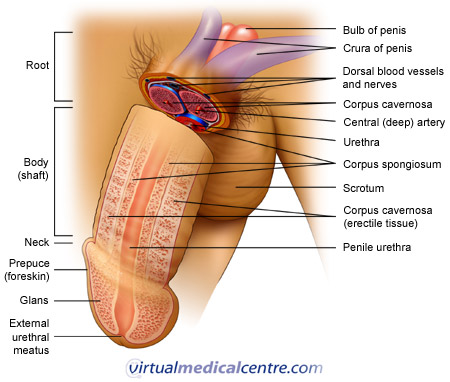- What is Premature Ejaculation?
- Statistics
- Risk Factors
- Progression
- Symptoms
- Clinical Examination
- How is it Diagnosed
- Prognosis
- Treatment
- References
What is Premature Ejaculation?

While the exact time at which a man’s ejaculation can be considered premature is not well defined, time from penetration to ejaculation (intravaginal ejaculatory latency time) of less than two minutes usually indicates premature ejaculation.
Research suggests there is considerable variation in the ejaculation times of men who do not consider themselves to ejaculate prematurely and those who do. Some men who ejaculate very quickly do not perceive their ejaculation to be premature, while others may complain of lack of ejaculatory control despite taking relatively long times to reach orgasm. This indicates that factors other than ejaculation time (e.g. partner’s sexual function, desired degree of control) also play a role in an individual’s experience and complaint of premature ejaculation. Therefore, when diagnosing premature ejaculation, doctors usually take into consideration the severity of psychological complications in addition to the actual ejaculation latency time.
Regardless of how long a man takes to ejaculate, most doctors will consider his ejaculation premature only if his ejaculation time is causing distress to the individual, or interpersonal difficulty or sexual dysfunction within his relationship.

Classifications of premature ejaculation
Premature ejaculation may be classified as either lifelong (also known as primary) or acquired (also known as secondary). Primary premature ejaculation is defined as having occurred at the first sexual encounter and persisted since then. Secondary premature ejaculation occurs after a period of normal sexual function in which the man was able to adequately control his ejaculatory function.
Two further classifications for premature ejaculation are sometimes used. These are normal variable (premature ejaculation which occurs variably or periodically) and premature-like (ejaculation which occurs more than two minutes after penetration but is perceived to be premature).
Statistics

The prevalence of lifelong and acquired premature ejaculation as defined by an intravaginal ejaculation latency time of less than two minutes is thought to be quite low (2–5%), but a much greater proportion of men (typically 20–30%) complain of premature ejaculation disorders in epidemiological studies. For example 23.8% of Australian men reported that they “came to orgasm too quickly” in the National Sex in Australia survey.
A study using a representative sample of the British population reported that a much lower proportion of men (11.7% of 16–44 year old men) experienced premature ejaculation at some point in the last year, though premature ejaculation was not defined for the respondents. This study also reported that the proportion of men who had experienced premature ejaculation in the past six months dropped to 2.7%, suggesting that the condition often comes and goes, but may affect a large proportion of men at some point in their life.
Risk Factors
Lifelong premature ejaculation is now thought to be an inheritable neurological condition. Individuals with first-degree relatives who suffer from premature ejaculation are predisposed to the condition.
Acquired premature ejaculation is associated with co-occurring conditions, including urethritis, prostatitis, hyperthyroidism, erectile dysfunction and obesity. Those who suffer from these conditions are more likely to experience acquired premature ejaculation than those who do not. It may also be caused by psychological factors such as relationship problems.
Progression
Premature ejaculation commonly co-exists with other sexual dysfunctions such as erectile dysfunction and sexual dysfunction in the female sexual partner (e.g. anorgasmia). The origins of an individual’s premature ejaculation may be organic (relating to the body) or psychogenic (relating to the individual’s mind).
The causes of premature ejaculation are often complex. Traditionally, it has been thought that the majority of premature ejaculation cases involve psychogenic factors. However, evidence has recently emerged which suggests that inheritable neurological factors lie at the root of most cases of primary premature ejaculation. Even in cases where premature ejaculation is organic in origin, psychogenic factors (e.g. lack of self esteem, relationship problems) may cause the condition to worsen.
While premature ejaculation does not harm the man’s body or genitals, it commonly leads to psychological problems, including relationship problems, sexual anxiety, lack of satisfaction with sex and avoidance of sexual activity. Premature ejaculation can also lead to sexual dysfunction in the man’s partner, who may be unsatisfied with sex or unable to orgasm.
Symptoms

Clinical Examination
When investigating the possibility of premature ejaculation, a doctor will probably perform a physical examination to check that the man is generally healthy. The doctor is also likely to examine the man’s genitals to assess whether or not there are infections which may be contributing to ejaculatory problems.
How is it Diagnosed
In the vast majority of cases, no specific tests are necessary to diagnose premature ejaculation. The diagnosis will usually be made on the basis of a man’s reports of ejaculatory control and resulting distress, and his answers to questions about his past health and sexual experiences.
Prognosis
Lifelong premature ejaculation cannot be cured, but can be managed with psychoeducational and/or pharmacological treatment in 75% of cases.
Acquired premature ejaculation can be treated by treating the underlying causes. For example, if a man has erectile dysfunction and ejaculates prematurely to compensate for his inability to maintain an erection, treating erectile dysfunction may also treat the premature ejaculation.
Treatment
Treatment of premature ejaculation focuses on enabling the male partner to develop control over his ejaculations, and both partners to develop satisfaction with their sex lives. Wherever possible, the treatment should involve both partners. A treatment plan should be developed to suits their tastes and sexual relationship.
Where premature ejaculation is acquired, the doctor will identify and treat the underlying cause (e.g. erectile dysfunction), rather than instituting treatment specifically for ejaculatory function control.
In cases of lifelong erectile dysfunction, treatment is likely to involve a range of treatments, including psychotherapy, behavioural and pharmacological treatment.
Lifelong premature ejaculation treatments
Non-pharmacological treatments

- Behavioural training: For up to fifty years, the treatment of premature ejaculation has involved training the man to control his ejaculation (e.g. the stop–start technique, in which the man will advise his partner to stop sexual stimulation when he begins to feel too highly aroused, then commence sexual activity soon after when the desire to ejaculate has diminished). There is no evidence that such training can cure premature ejaculation and couples may find this technique disruptive to sexual activity;
- Reducing penile sensation: Condoms can be used in the treatment of premature ejaculation as they cover penis and reduce its sensitivity. There is no clinical evidence regarding the effectiveness of using condoms to delay ejaculation. A range of topical anaesthetics can reduce penile sensation, including lignocaine-prilocaine aerosols and creams, and lignocaine spray. These creams must be applied less than half an hour before sexual intercourse. In some cases, they can cause erectile dysfunction as a result of reduced sensation;
- Physiotherapy: Physiotherapy, particularly pelvic floor exercises, has been used in clinical practice. However, there is a lack of scientific evidence regarding their effectiveness in delaying ejaculation;
- Counselling: Many men with premature ejaculation also have associated psychological problems (e.g. lack of self esteem and sexual anxiety), although these tend to be caused by premature ejaculation rather than being the cause. As such, counselling (sexual therapy) should be conducted in combination with other therapies. It is not demonstrated to be an effective treatment when used alone.
Pharmacological treatments
A number of pharmaceuticals have been employed in the treatment of premature ejaculation, administered either on a daily basis, or on-demand before sexual activity. Available medications include:
- Tricyclic antidepressants: The antidepressant clomipramine (e.g. Anafranil, Placil) has proven effective in delaying ejaculation, although its side effects may in turn inhibit sexual function. One study found that clomipramine treatment resulted in increased sexual satisfaction for both partners, but side effects included dizziness, nausea, constipation and hot flushes. This medication can be administered either daily or just before sexual activity;
- Selective serotonin reuptake inhibitors (SSRIs): SSRIs, including paroxetine (e.g. Oxetine, Paxtine, Aropax),11 fluoxetine (e.g. Fluohexal, Flouxebell, Lovan, Zactin) and sertraline (e.g. Concorz, Eleva, Sertra, Setrona), can delay ejaculation. However, the slow onset of their effect means that daily doses are necessary, rather than on-demand doses just before sexual activity. In addition, SSRIs can reduce libido and inhibit orgasm;
- Phosphodiesterase (PDE-5) inhibitors: PDE-5 inhibitors such as Cialis (tadalafil), Levitra (vardenafil) or Viagra (sildenafil) are the most common treatment for erectile dysfunction, and have also been used in the treatment of premature ejaculation. While they have been associated with a greater perception of ejaculatory control amongst men with premature ejaculation, there is no evidence that they significantly increase intravaginal ejaculation latency times.
Acquired premature ejaculation treatments

- Prostatitis and urethritis: Appropriate antibiotic therapy;
- Erectile dysfunction: PDE-5 inhibitors;
- Relationship problems: In some cases stress or difficulties in a relationship may cause, rather than be caused by, premature ejaculation. In such cases, couples should receive counselling and/or sex therapy.
Natural variable ejaculation treatments
Men whose ejaculation time is naturally variable typically cope well with their sometimes-premature ejaculations and rarely seek treatment. In cases where men with naturally variable ejaculation times do seek treatment, therapy should focus on psychogenic factors, for example providing them with information about typical intravaginal ejaculation latency times and reassuring them of the normality of their sexual performance. It is usually not appropriate to institute pharmacological therapy.
Premature-like ejaculation treatments
Men with premature-like ejaculation perceive their intravaginal ejaculation latency time to be short, when it is actually within the normal range (and may even be in the long range). The disorder is primarily psychogenic, and first line treatment focuses on psychoeducation and counselling. Pharmacological therapy is generally not appropriate for treating premature-like ejaculation.
More information
 |
For more information on erectile dysfunction, types, causes and treatments of erectile dysfunction, and tips for dealing with it, see Erectile Dysfunction. |
References
- International Statistical Classification of Diseases and Related Health Problems: Version 10 [online]. Geneva: World Health Organization; 5 April 2006 [cited 14 May 2008]. Available from: URL link
- Gregorie A. ABC of sexual health: Assessing and managing male sexual problems BMJ. 1999;318(7179):315-7. [Abstract | Full text]
- Palmer NR, Stuckey BG. Premature ejaculation: A clinical update. Med J Aust. 2008;188(11):662-6. [Abstract | Full text]
- Richardson D, Goldmeier D, Green J, et al. Recommendations for the management of premature ejaculation: BASHH Special Interest Group for Sexual Dysfunction. Int J STD AIDS. 2006;17(1):1-6. [Abstract]
- Waldinger MD. Premature ejaculation: Advantages of a new classification for understanding etiology and prevalence rates. Sexol. 2008;17(1):30-5. [Abstract]
- Richters J, Grulich AE, de Visser RO, et al. Sex in Australia: Sexual difficulties in a representative sample of adults. Aust NZ J Public Health. 2003;27(2):164-70. [Abstract]
- Mercer CH, Fenton KA, Johnson AM, et al. Sexual function problems and help seeking behaviour in Britain: National probability sample survey. BMJ. 2003;327(7412):426-7. [Abstract | Full text]
- Hull EM, Muschamp JW, Sato S. Dopamine and serotonin: Influences on male sexual behaviour. Physiol Behav. 2004;83(2):291-307. [Abstract]
- Schedule of pharmaceutical benefits: Clomipramine. Parramatta, NSW: Australian Government Department of Health and Ageing; 2008 [cited 14 May 2009]. Available from: URL link
- Althof SE, Levine SB, Corty EW, et al. A double-blind crossover trial of clomipramine for rapid ejaculation in 15 couples. J Clin Psychiatry. 1995;56(9):402-7. [Abstract]
- Schedule of pharmaceutical benefits: Paroxetine [online]. Parramatta, NSW: Australian Government Department of Health and Ageing; 2008 [cited 14 May 2009]. Available from: URL link
- Schedule of pharmaceutical benefits: Fluoxetine [online]. Parramatta, NSW: Australian Government Department of Health and Ageing; 2008 [cited 14 May 2009]. Available from: URL link
- Schedule of pharmaceutical benefits: Sertraline [online]. Parramatta, NSW: Australian Government Department of Health and Ageing; 2008 [cited 14 May 2009]. Available from: URL link
- Mulhall JP. Current and future pharmacotherapeutic strategies in treatment of premature ejaculation. Urology. 2006;67(1):9-16. [Abstract]
- Waldinger MD, Zwinderman AH, Schweitzer DH, Olivier B. Relevance of methodological design for the interpretation of efficacy of drug treatment of premature ejaculation: A systematic review and meta-analysis. Int J Impot Res. 2004;16(4):369-81. [Abstract | Full text]
- El-Nashaar A, Shamloul R. Antibiotic treatment can delay ejaculation in patients with premature ejaculation and chronic bacterial prostatitis. J Sex Med. 2007;4(2):491-6. [Abstract]
All content and media on the HealthEngine Blog is created and published online for informational purposes only. It is not intended to be a substitute for professional medical advice and should not be relied on as health or personal advice. Always seek the guidance of your doctor or other qualified health professional with any questions you may have regarding your health or a medical condition. Never disregard the advice of a medical professional, or delay in seeking it because of something you have read on this Website. If you think you may have a medical emergency, call your doctor, go to the nearest hospital emergency department, or call the emergency services immediately.







